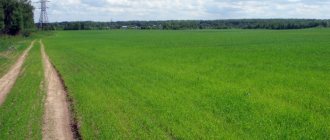The expediency of transferring land to individual housing construction is clear. The cost of such land will be higher, and the owner or possessor has the right, if he has an issued building permit, to build a cottage and thereby improve his living conditions.
Dear readers! The article talks about typical ways to resolve legal issues, but each case is individual. If you want to find out how to solve your particular problem , contact a consultant:
+7 (499) 938-81-90 (Moscow)
+7 (812) 467-32-77 (Saint Petersburg)
8 (800) 301-79-36 (Regions)
APPLICATIONS AND CALLS ARE ACCEPTED 24/7 and 7 days a week.
It's fast and FREE !
The law allows for the transfer of agricultural land, as well as plots from such land, in exceptional cases, which is expressly stated in Art. 7 Federal Law No. 172. Land transfer is possible if the boundaries of the municipality change, that is, when the site becomes part of the municipality.
General information
A change in purpose is possible when a municipality, with a positive expert opinion, carries out a comprehensive transfer of a large piece of land at once and divides it into individual housing construction plots - with an area of 4, 6, 10 acres or more.
Such an organized translation requires a thorough examination and the absence of objections from the owners of the plots - individuals, legal entities and other subjects of civil legal relations.
The following are taken into account: the ecological situation of the area, the availability of infrastructure and the prospect of carrying out utilities to the site of future construction of private houses.
The possibility of transfer is provided, but may be difficult if the site is actively used or when located remotely from a populated area. Within the framework of expanding the boundaries of a municipal entity, translation is most favorable, since it is often carried out in an organized manner and initiated by municipal authorities.
If individual housing construction lands directly border the territories of private household plots, transfer is likely, but only if it is possible to lead to a communications site or when the lands do not belong to the most valuable agricultural land - for example, water meadows or highly cultivated areas of special use.
Possible nuances
Urgent work. Yes, after the transfer, owners of individual housing construction must obtain official permission to carry out construction. Having finished with the papers, they begin work. The Department of Architecture, which issues such permits, considers 10 years a sufficient period for the construction of a full-fledged residential building. Local authorities will monitor the pace of work. If a citizen does not pour at least the foundation in the first 3 years of using the allotment, then it can be given to another, active user.
Registration of an individual technical passport - this applies to the site plus the future home. It is issued by the BTI as soon as specialists check the plot and create its plan.
Creating a mailing address. Each house has its own number and postal address. The citizen must submit the appropriate application himself, confirming it with a technical passport and a permit previously issued by the Department of Architecture.
Carrying out systems. It is planned to build a real residential building where people will stay permanently. Therefore, he will need to sign agreements with all resource-providing companies. To provide electricity, establish a telephone (landline) connection, water supply, and, if necessary, gas. After all, some people simply use electricity without having gas stoves. Think about heating. Install your own gas boiler, make stove heating or install central heating. The peculiarity of the settlement is important here. Many towns and villages have ordinary houses where people heat the stove. However, these are related problems that are resolved as they arise.
The beginning of the process will still be a change in category. Some, instead of individual housing construction, transfer their private household plots to agricultural enterprises in order to engage in fishing or other similar activities there. Here it is important to adapt the land to your current needs. So that the allotment does not stand idle for years. Such real estate cannot be treated as a useless source of costs, because landowners still pay taxes. It is not for nothing that the state has developed special programs according to which people can, if necessary, change the existing characteristics of their lands.
Purpose of land
Art. 4 of the Federal Law of July 7, 2003 “On Private Private Farms” provides for the division of private household plots into household plots of private household plots, which are located within populated areas and field plots located outside the populated area.
On a personal plot of private household plot, you can build a residential building, erect other buildings and structures, even without transferring the land to the category of individual housing construction. Field plots of private household plots are intended only for the production of agricultural products.
Individual housing construction plots are intended exclusively for individual housing construction and outbuildings - garages, workshops, etc.
It is prohibited to use such lands for growing agricultural products, but it is not forbidden to build a small garden or vegetable garden on them, next to a private house. On both categories of land, the construction of a private house is permitted only with a properly executed permit.
Types of land plots
Land plots of private household plots related to settlement lands are called household plots. On such plots it is allowed to build houses and outbuildings and engage in self-employment.
Read more about personal plots in a special article.
Private household plots on agricultural land are called field plots. On field plots, agricultural activities are permitted without the possibility of erecting permanent buildings .
Read more about field sites in the article.
Normative base
The main regulatory act is considered to be Federal Law No. 172, adopted in 2004. The status of private plots is determined by Federal Law No. 112 dated July 7, 2003.
The procedure for making an entry in the Unified State Register of Real Estate about changing the category and intended use of a land plot is outlined in Federal Law No. 218 of July 13, 2015 “On State Registration of Real Estate.”
How to transfer private household plots to individual housing construction
You will need to apply to local authorities. Before applying, the owner of the site must ensure that the property's title documents are properly executed.
The application is made in writing, with the obligatory attachment of documents to the application.
What is the difference?
In order to figure out how to convert private household plots into individual housing construction, you need to understand the basic differences between these two categories of land.
Plots of private household plots are agricultural lands, which can be located within populated areas and beyond its borders. They can be intended for the production of agricultural products and the construction of a private house (if the site is located in a populated area).
Individual housing construction lands are located exclusively in populated areas. They are intended for the construction of a private house (no higher than three floors) and for no more than two owners.
Find out about the necessary documents for registering an individual housing construction house. What are the rules for developing individual housing construction? See here.
Step by Step Actions
- Required documents
A package of documents is the first thing that needs to be collected to carry out the re-registration procedure:
- passport of a citizen of the Russian Federation. Not only will you need copies of the required pages, but also the original.
- title documents, extract from the Unified State Register, etc.;
- approval from the owner of the land plot if the land was leased or transferred for lifelong free use;
- the original cadastral passport or an extract from the Unified State Register of Real Estate, in which the cadastral number will be registered;
- You will need to obtain a certificate from a geodetic company indicating the exact coordinates of the land;
- You will also need a certificate stating whether the site is located within the boundaries of a populated area or not.
- Completing and submitting an application
You can submit an application to a specific department of the municipality or to the MFC. The application form does not have a specific standard, but has mandatory items, namely:
- personal data of the owner and applicant;
- cadastral number for the plot;
- status of the land at the time of application;
- the required category and type of purpose for the ILI;
- reason for re-registration of the land plot;
- legal factors that allow the disposal of land.
The lawful use of land of a certain category is closely monitored by the state. As a result, the reason for transferring land to another category must be very respectful and weighty.
Re-registration procedure
The owner or possessor of a land plot must collect title documents and contact the municipal administration at the location of the land.
There is no application form provided at the federal level. It is developed directly by local government bodies, but the content of the document should not contradict Part 3 of Art. 2 Federal Law No. 172.
The application, with all attached documents, can be submitted in person or through a legal representative. It is reviewed by local government experts.
The procedure requires an examination, which is the responsibility of Rosprirodnadzor and environmental assessment bodies at the regional level. It is carried out at the expense of the customer of the documentation.
List of required documents
To find out how to transfer a plot of land from private plots to individual housing construction, you must submit the following documents:
- a copy of the passport or other document that identifies the applicant;
- an extract from the Unified State Register of Individual Entrepreneurs or the Unified State Register of Legal Entities, if the initiator of the land transfer is an individual entrepreneur or organization;
- conclusion of the SEE (state environmental assessment). Must be ordered and paid for in advance.
The cost and procedure for registration are determined at the regional level. Permission from the owner of the site will be required if an easement was previously established on the property. The list of documents is considered exhaustive.
Statement
It is submitted in the form of a petition. It should indicate:
- cadastral number of the plot;
- category of land (LPH) and individual housing construction (to which the original plot should be transferred);
- convincing reason;
- rights to a land plot (for this you will need to issue an extract from the Unified State Register of Real Estate).
The application must be considered within two months from the date of receipt.
Based on the results of the consideration, the authorized local government body accepts an act on the transfer of land or refuses to satisfy the request.
A sample petition for transfer of one category of land plot to another is here.
Price
This procedure cannot be called cheap. Most of the funds contributed by the owner account for the payment of compensation to the state for the loss of agricultural land.
The cost consists of the following fees:
- state duty for the withdrawal of agricultural land from circulation (30% of the cadastral value of the plot);
- obtaining an extract from the Unified State Register of Real Estate;
- preparation of documents and development of a project for the construction of a residential building;
- environmental assessment.
Grounds for refusal
The application will not be considered if it was submitted by an inappropriate person or if incorrectly completed documents were attached to the application. Then the application must be returned within 30 days from the date of its receipt for consideration.
The reasons for refusing to consider an application must be stated in writing.
There are three grounds for refusing a transfer:
- if the lands are not subject to transfer due to the actual impossibility of the procedure - they are located outside the populated area, constitute valuable agricultural land, etc.;
- with a negative expert opinion;
- if the intended use in the form of individual housing construction is impossible for technical reasons.
The act of refusal to transfer must be issued within two months from the date of acceptance of the application. It may be challenged in court. To do this, you will have to file an administrative claim.
Read about obtaining land for individual housing construction for free. Is it possible to transfer to SNT in individual housing construction? Information here.
How is individual housing construction deciphered? Details in this article.
What requirements must the land plot meet?
To transfer to individual housing construction, the land of private household plots must meet the following requirements:
- Located within the boundaries of a populated area.
- Treated as agricultural land.
- There should not be any buildings on the site whose height exceeds 3 floors.
- Absence of any production premises on the site (if any, they must be demolished before starting the transfer process).
The following types of land fall under a categorical ban on transfer to individual housing construction:
- lands used for sowing grain crops;
- meadows;
- pastures;
- strategically important areas of land, test sites, etc.
Transfer certificate
The transfer act in 2021 contains the following information:
- the grounds for such a decision;
- a detailed description of the site;
- original category and intended purpose of the site;
- the category into which the land has been transformed.
The act is not limited to a specific period. It is sent to the applicant within two weeks from the date of acceptance. Changes are considered to come into force from the moment of their state registration in Rosreestr. Re-registration of title documents for the site will not be required.
Before the procedure, you should take into account that a house can also be built on the lands of private household plots, if they are located in populated areas, and transfer to individual housing construction can be costly. In a sensitive situation, it is advisable to enlist the help of a qualified lawyer in the field of land law.
Advantages
Even at the initial stage of re-registration of land from private household plots to individual housing, the territory already has its own personal address, at which you can later register your family. Among other things, for the future building, at the expense of the state, you can get an asphalt road to the house and all the necessary communications.
All participants in the ILI can subsequently receive benefits from the state for paying taxes. Objects that are built by owners on lands with ILI status are necessarily included in urban planning plans. Accordingly, schools, shops, hospitals and other infrastructure facilities may soon appear nearby.









